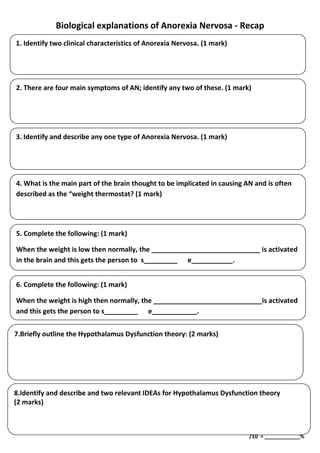Report
Share
Download to read offline

More Related Content
Similar to Recap for hdt students
Similar to Recap for hdt students (20)
Craig aronoff hw410 01 unit 9 resource guide project.doc

Craig aronoff hw410 01 unit 9 resource guide project.doc
MOTOR AND NEUROLOGICAL IMPAIRMENTS (DIHCA Module 5).pptx

MOTOR AND NEUROLOGICAL IMPAIRMENTS (DIHCA Module 5).pptx
More from sssfcpsychology
More from sssfcpsychology (20)
Recap for hdt students
- 1. Biological explanations of Anorexia Nervosa - Recap 1. Identify two clinical characteristics of Anorexia Nervosa. (1 mark) 2. There are four main symptoms of AN; identify any two of these. (1 mark) 3. Identify and describe any one type of Anorexia Nervosa. (1 mark) 4. What is the main part of the brain thought to be implicated in causing AN and is often described as the “weight thermostat? (1 mark) 5. Complete the following: (1 mark) When the weight is low then normally, the _____________________________ is activated in the brain and this gets the person to s_________ e___________. 6. Complete the following: (1 mark) When the weight is high then normally, the _____________________________is activated and this gets the person to s_________ e____________. 7.Briefly outline the Hypothalamus Dysfunction theory: (2 marks) 8.Identify and describe and two relevant IDEAs for Hypothalamus Dysfunction theory (2 marks) /10 = ____________%